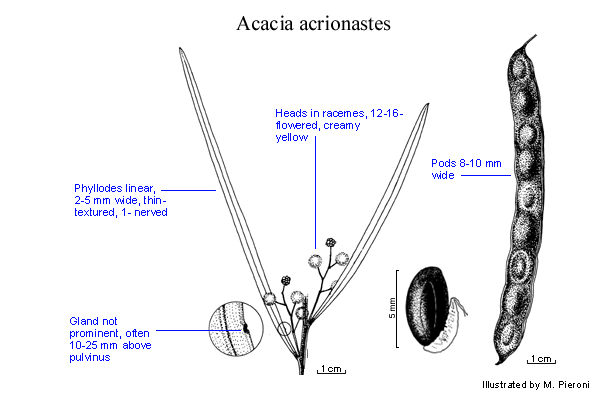Acacia acrionastes Pedley
WATTLE
Acacias of Australia
Family
Fabaceae
Distribution
Geographically restricted in south-eastern Qld where it occurs on Mts Barney, French, Gillies and Maroon.
Description
Spindly, glabrous shrub or tree 2–8 m high. Phyllodes linear, 6–19 cm long, 2–5 mm wide, often ±gradually narrowed towards apex, thin, smooth or very finely wrinkled when dry, 1-nerved per face; lateral nerves obscure or absent; gland not or scarcely exserted beyond margin, 10–30 (–45) mm above pulvinus. Inflorescences 10–16-headed racemes; raceme axes 2–4.5 cm long; peduncles 3–6 mm long; heads globular, 12–16-flowered, creamy yellow. Flowers 5-merous; sepals united into a ±truncate calyx. Pods to 10 cm long, 8–10 mm wide, thinly coriaceous. Seeds longitudinal, elliptic, 4.5–5 mm long, ±shiny, black; aril clavate.
Habitat
Grows in Eucalyptus forest in shallow rocky soil derived from rhyolite or basalt and in heath among rocks on mountain peaks, to 1200 m alt.
Specimens
Qld: Mt French, 12 km SW of Boonah, L.H.Bird AQ473431 (BISH n.v., BRI n.v., CANB, K n.v., MEL n.v., MEXU n.v., MO n.v., NSW, PERTH); Mt Maroon, S.L.Everist 7110 (BRI): Mt Gillies, 20 km SW of Rathdowney on Mt Lindsay Hwy, P.Sharpe 1072 (BRI); Mt Barney, C.T.White 7843 (BRI).
Notes
Most closely related to A. floydii which has slightly narrower phyllodes with more prominent glands nearer the base and fewer flowers per head. Formerly confounded with A. adunca which has bright golden flower-heads and uncinate, thicker, generally narrower phyllodes. Phyllodes ±resembling those of A. macnuttiana.
FOA Reference
Data derived from Flora of Australia Volumes 11A (2001), 11B (2001) and 12 (1998), products of ABRS, ©Commonwealth of Australia
Author
B.R.Maslin
Minor edits by B.R.Maslin & J.Rogers
This identification key and fact sheets are available as a mobile application:
URL: https://apps.lucidcentral.org/wattle/
© Copyright 2018. All rights reserved.







